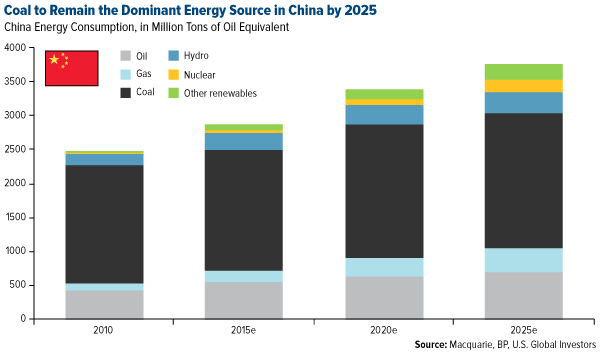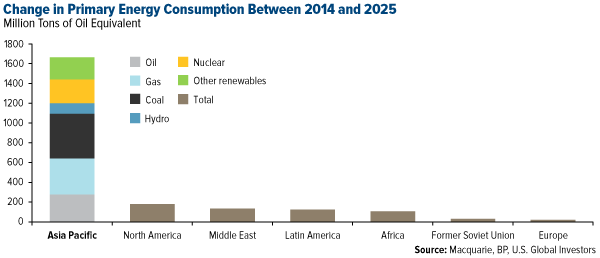Resource investors, take note: By 2025, just 10 years from now, energy consumption in Asia will increase a whopping 31 percent. A whole two-thirds of that demand, driven largely by China and India, will be for fossil fuels, most notably coal.
That’s according to a new research piece by financial services group Macquarie Group Ltd (ASX:MQG), which writes that the estimated rise in fossil fuel demand is equivalent of “three times Saudi Arabia’s current (all-time-high) oil production.”
Macquarie’s research is in line with BP’s “Energy Outlook 2035,” released earlier this year, which predicts that more than half of the world’s energy consumption will come from China and India by the year 2035.
Many readers might approach this news with a healthy dose of skepticism. Haven’t we been told that fossil fuels are falling out of favor? Aren’t governments placing caps on coal use to appease environmentalists and climate change crusaders?
It’s true that coal demand in China has declined a huge 6 percent so far in 2015, the result of anti-air pollution laws that temporarily restricted not just coal use but also factory operations and the amount of driving you can do. Last month I shared a striking photo of a man cycling through Beijing, a brilliant blue sky overhead—something I’ve personally never seen in my 25 years of visiting the city. As most people know, Beijing is notorious for its noxious yellow haze, and the government has been pressured lately to act. In Shanghai, authorities plan to close and relocate 150 factories in preparation for the proposed Shanghai Disneyland, the thinking being that the “Happiest Place on Earth” must have clear blue skies.
I think we all agree that clean air is preferable to smog, but there needs to be a balanced approach to environmental policy that’s also business-friendly.
“Coal producers within China are definitely facing a consistent push by the government for clean energy,” says Xian Liang, portfolio manager of our China Region Fund (USCOX).
To get a better sense of the biblical quantity of raw materials China currently consumes, check out this infographic courtesy of Visual Capitalist.
Can India Pick Up China’s Slack?
Today, China and India collectively consume about 60 percent of all coal produced in the world. In absolute terms, consumption is expected to continue expanding as their populations balloon and the energy-thirsty middle class expands. In other words, as the energy pie gets much bigger, each slice should likewise grow.
By 2025, Macquarie writes, coal will still play a dominant role in China’s energy mix.

It’s possible that if China’s coal consumption dramatically declines, India will be there to fill the hole. Macquarie estimates that by 2025, India’s energy demand will rise 71 percent, with coal taking the lead among oil, gas, hydro, nuclear and others. The south Asian country is already the second-largest importer of thermal coal, and it might very well surpass China in the coming years.
Macquarie writes:
Although all energy use will rise [in India], coal is the major theme as consumption and local production are both set to almost double by 2025 on the back of large-scale coal power plant construction plans.
The group adds that, unlike China, India has no present interest in reigning in its use of coal. Most emerging markets, India included, recognize that coal is an extremely affordable and reliable source of energy, necessary to drive economic growth.
Even if these predictions don’t come to fruition, the consensus is that we haven’t yet seen peak coal use in Asia. Estimates vary depending on the agency, but everyone seems to agree that demand in the medium-term will rise before it retreats. A 2014 MIT study even suggests that Chinese coal consumption could rise more than 70 percent between 2012 and 2040.

Follow the Smart Money
With prices at multi-year lows and coal producers under pressure, some big name investors have used this as an opportunity to accumulate shares in depressed stocks. Recently I shared with you that influential billionaire investor George Soros just took a $2-million position in coal producers Peabody Energy and Arch Coal.
Maybe he’s on to something, if Macquarie’s research turns out to be accurate.
No one can deny that fossil fuels, and coal in particular, face many headwinds right now, including government policies intended to limit their use. The strong U.S. dollar has created havoc for commodities such as oil and coal, just as it has for American companies with business activities in foreign countries. And with many central banks around the globe continuing to devalue their currencies against the dollar, a strong greenback might be the “new normal” for a while.
Also like oil, coal is facing oversupply issues, as producers had not anticipated a slowdown in emerging markets.
But there and elsewhere, coal will continue to play a vital role in providing affordable, reliable energy for decades to come.
Foreign and emerging market investing involves special risks such as currency fluctuation and less public disclosure, as well as economic and political risk. By investing in a specific geographic region, a regional fund’s returns and share price may be more volatile than those of a less concentrated portfolio.
Fund portfolios are actively managed, and holdings may change daily. Holdings are reported as of the most recent quarter-end. Holdings in the China Region Fund as a percentage of net assets as of 6/30/2015: Peabody Energy Corporation 0.00%, Arch Coal 0.00%.

